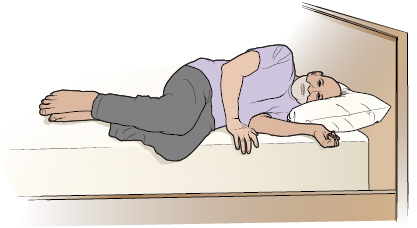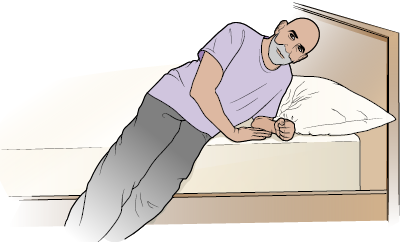This information explains how to protect your sternum (breastbone) after your median sternotomy (MEE-dee-un STER-NAH-toh-mee).
A median sternotomy is a procedure to separate your sternum during surgery. First, your doctor makes an incision (surgical cut) in the center of your chest. Then, they cut through your sternum, splitting it in half and spreading the 2 sides apart. This is done so your doctor can reach the body parts under your sternum.
A median sternotomy is often done during a thymectomy (THY-mek-toh-mee). A thymectomy is a surgery to take out your thymus gland, which is a small organ under your sternum. When your surgery is done, your doctor puts the 2 halves of your sternum back together.
After your surgery, you will need to protect your sternum while it’s healing. Your nurse or healthcare provider will go over these instructions with you before you leave the hospital.
How to protect your sternum when you’re in the hospital and at home
Most people should follow these instructions for 6 weeks after surgery. Your healthcare provider may tell you to follow them for more or less time. Follow their instructions.
- Hold a pillow against the incision on your chest when you cough or sneeze. This is called splinting your incision. Splinting your incision helps ease pain at your incision when you cough or sneeze.
- Do not reach backward with both arms at the same time. For example, do not reach behind you to scratch your back or hook the clasp on your bra.
-
Do not lift or carry anything heavier than 10 pounds (4.5 kilograms). A gallon of milk weighs about 8 pounds (3.6 kilograms).
- Right after your surgery, objects lighter than 10 pounds (4.5 kilograms) may feel too heavy. Do not lift or carry anything that causes pain or discomfort.
-
When getting up from a chair, off the toilet, or out of bed:
- Put most of your weight on your legs and use your leg strength to stand.
- Keep your arms close to your body.
-
Keep your upper arms close to your body when you’re lifting, pushing, or pulling. Do not lift, push, or pull anything that causes pain or discomfort. Examples of lifting, pushing, and pulling are:
- Pulling or pushing on the banister or railing while you’re going up or down stairs.
- Opening and closing heavy doors.
- Walking a dog on a leash.
- Using your arms while you’re getting up from a chair, off the toilet, or in and out of bed.
- Lifting or carrying objects less than 10 pounds (4.5 kilograms), such as pots and pans.
- Talk with your healthcare provider before you go back to exercising.
Getting in and out of bed
It’s important to get in and out of bed slowly and carefully to protect your sternum.
How to get out of bed
-
Move your feet to the edge of the bed. Roll onto your side (see Figure 1).

Figure 1. Roll onto your side - Gently move your legs over the side of the bed.
-
Carefully use your arms to help yourself sit up (see Figure 2). Make sure you keep your arms close to your body.

Figure 2. Use your arms to help yourself sit up
How to get in bed
-
Sit on the side of the bed (see Figure 3).

Figure 3. Sit on the side of the bed - Carefully use your arms to help yourself lie down. Make sure you keep your arms close to your body.
- Gently move your legs over the side of the bed.
You can sleep in any position that does not cause discomfort. Many people are most comfortable on their side.